Reading Time: 20 Minutes
The influencer marketing industry is expected to nearly triple in spending between 2019 and 2024, and for a good reason: More than ever before, creators are impacting what consumers buy. And if you’re like most brands, you want to know how influencer-generated content can help you connect with your target audience.
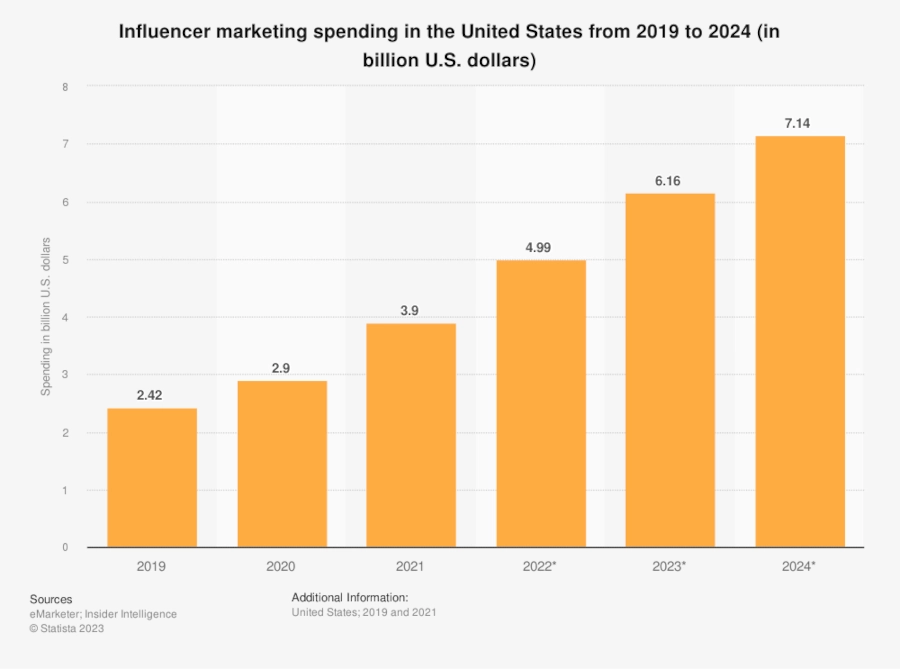
Images via Statista
As the name suggests, influencer-generated content is all content sourced from influencers that mentions your brand in a positive light. These posts don’t have to be brand sponsored. In fact, some of the best influencer-generated content occurs without you asking the influencer to do so.
Traditionally an influencer is a social media user with an online community of at least 1,000 followers on any given channel. The influencer is a trusted source to their community and actively engages with them. Audiences look to influencers for inspiration and information, including purchase recommendations.
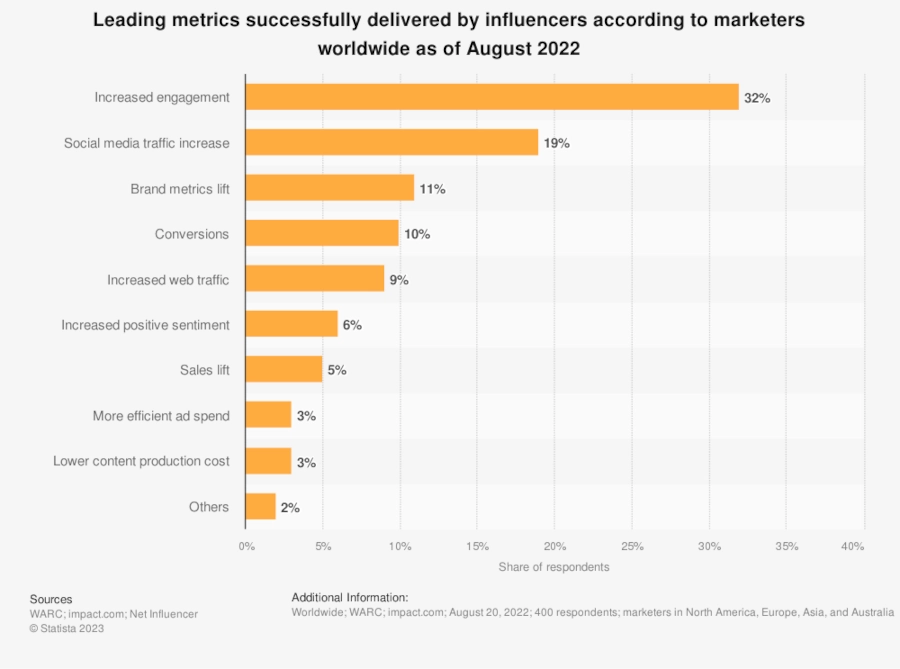
Image via Statista
Influencer-generated content also offers your brand visibility in a highly saturated market. With so much noise from brands trying to compete against each other in getting their voices heard, consumers have developed selective attention and retention. This means that consumers will only pay attention to what truly interests them and ignore the rest.
However, influencer-generated content is extremely effective in getting the attention of your target audience because their followers have opted to receive their messages and view their content.
Additional ongoing benefits of influencer content include:
“Moving the needle” on social media is becoming increasingly difficult as users flood platforms and paid ad ROI depreciates with repetition. To retain the authenticity that users demand, social platforms increasingly favor the efforts of creative experts.
These creators consistently publish compelling content and can curate a fan base around a particular lifestyle or set of values. Some of these users are photographers, videographers, and bloggers, but many are ordinary people with a unique voice that cuts through the “social noise.” They typically offer a multi-platform strategy and an effective, comprehensive way to promote your product or brand.
The demand for authenticity is such that brands can’t compete with influencer content on consumer newsfeeds without help from those influencers.
“I believe that companies that don’t collaborate with influencers are going to be spending more and more money on paid social, and it becomes less and less effective over time.”
— Neal Schaffer on the GRIN Gets Real podcast
In short, consumers don’t trust a brand’s content or their paid advertising in the same way that they trust their favorite influencers. Any social media approach that ignores influencer-generated content is simply unsustainable.
For a user, content credibility is of utmost importance. When all the information you come across online is grounds for skepticism, potential customers can be persuaded to buy a product when someone they trust recommends it. Research shows that micro influencers may be the key to building the most authenticity, as research shows that people are more likely to trust “normal people” over celebrities.
Enable your influencers to create more authentic and engaging content by sharing your brand’s values and story with them. In fact, 89% of marketers use influencer marketing because it helps them create authentic content about their brand.
Here are some additional methods for building authenticity in influencer-generated content.
One of the best ways to separate fake influencers from real influencers is to review their engagement rate.
Just because an individual has thousands (or millions) of likes or followers doesn’t guarantee that those followers are engaged. If you divide the number of comments and shares by the number of likes or followers, you can determine an engagement rate for that influencer.
After finding an influencer’s engagement rate, you should examine the content of follower engagements. By paying attention to the conversations between an influencer and their fans, you’ll discover how authentic the connection of the influencer is with your target audience.
“At first, I had the mindset that they have to have 10,000 followers or above. I feel like that was just the norm—we want people with a lot of followers. But what I’ve found is that it was the people that came into the brand and have a lot of passion for it. We switched from going after the amount of followers to their engagement on social media. By switching my mindset—they don’t need to have a lot of followers—I look for their passion for the brand and their engagement.”
– Victoria Shanley, Director of Operations and Marketing at Frenchie Bulldog
Speaking of “passion,” the best influencers only partner with brands that bring them genuine delight. Many influencer marketers refer to these people as “brand ambassadors” because those influencers sincerely love the brand’s products or services.
Audiences can tell the difference between fake and genuine excitement, and when they spot the latter, it’s contagious.
Recently, opt-in influencer networks have offered to connect brands with influencers and vice versa. These “middleman” agencies appear on the surface to streamline the influencer marketing process. But upon closer examination, the middleman approach dilutes influencer authenticity.
“When brands treat influencer marketing this way—like it’s an ad buy—and use a middleman who prioritizes transactions, influencer marketing fails. The content isn’t trustworthy. At best, this transactional approach ruins the benefits of influencer marketing. At worst, it can lead to disastrous consequences for the brand.”
– GRIN, Authentic Influencer Marketing
Experienced marketers understand that to achieve the most authentic influencer-generated content, they need to work directly with influencers. That said, managing influencer relationships can be a daunting task without the appropriate influencer marketing software.
While there is nothing wrong with strategic “one-off” influencer campaigns, long-term relationships with your best influencers further nurture authenticity. Brand-influencer partnerships that share the same values and have a foundation of trust can achieve enormous returns.
“Brands need to see influencers not as a transaction, but as a real connection.”
– GRIN, Authentic Influencer Marketing
Influencer marketing managers take time to get to know their influencers. Many marketers pay attention to influencer birthdays, personal milestones, and general well-being. The human touch enhances the power of influencer-generated content.
Brands are very conscious about their positioning and how they present messages to their audiences. Because of this, they sometimes end up being overly restrictive with their content guidelines for influencers.
But what happens if you let your influencers create content entirely based on their own creativity? Greater engagement.
Followers of an influencer love the kind of content they post. That’s the main reason why they follow these people. So don’t restrict influencers with rigid guidelines. According to Crowdtap, 76% of influencers prefer working with brands that give them creative freedom.
Influencers often assume dual roles of industry experts and trusted friends. Consumers prefer to gather information for themselves and with the help of other consumers before believing what a brand has to say about its own products and services.
Leveraging influencers to convey information to your audience can help you build credibility and differentiate your products from your competitors’.
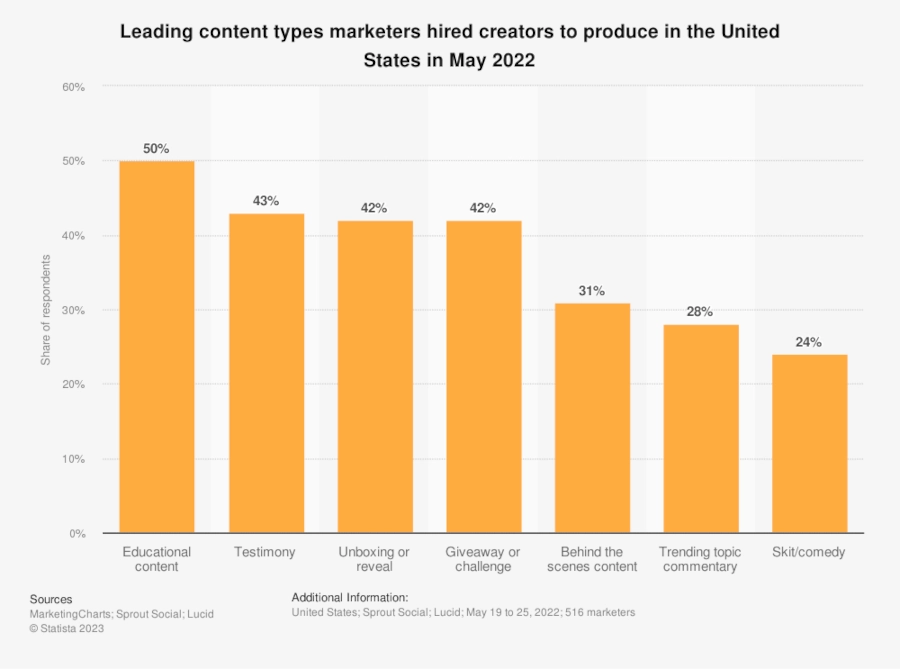
Image via Statista
Examples of influencer-generated content that inform your audience include:
If you’re like most brands today, you do business a certain way and serve a particular audience. Both of these choices demonstrate that you have values and seek to reach consumers with a specific lifestyle.
Influencers frequently connect with consumers on social issues and lifestyle choices. When you achieve audience alignment with an influencer, you will build consumer excitement that is deeper than a surface appreciation for your products.
In other words, influencers help you achieve brand loyalty based on your brand’s unique DNA. Examples of this kind of influencer content include:
If there’s one thing that influencers do very well, it’s getting the word out to niche audiences. Influencer posts that help you make relevant announcements receive far more impressions and engagements than if you’d tried to make those announcements yourself.
Influencers can get the word out in many different ways, including:
Blogger influencers can significantly contribute to your website’s search engine rankings. Not only will they drive traffic to your website, but if the influencer’s website has a high domain authority, then a backlink to your site could raise your domain authority, too.
Brands are increasingly looking for ways to be authentic. An influencer collaboration could help consumers get a “behind the scenes” look at your business. This tactic can endear audiences to your brand and raise brand awareness.
When most marketers think about influencer-generated content, they typically envision social media posts. And while it’s true that the vast majority of influencer content takes place on social media, many marketers are looking for ways to add value by integrating influencer posts with their existing web content.
This approach should be mutually beneficial for the brand and influencer.
For example, SlumberPod illustrates some great ways to weave influencer-generated content throughout its website.
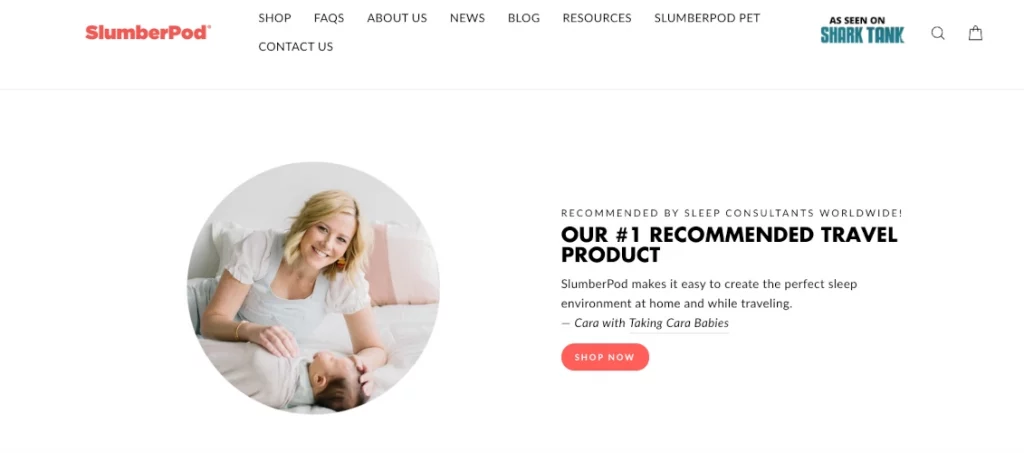
Particularly on YouTube, “how-to” tutorials are among the most-watched types of content online today. Additionally, instructions and product questions are frequent searches on Google.
After an influencer posts a tutorial or question-answer post on their social channel, you can embed that post or video into sections of your website.
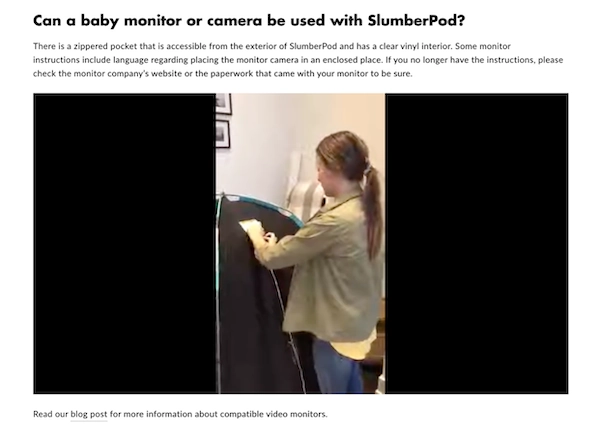
Consumers love watching influencers unbox products or compare several products at once. These videos help your customers make a wise purchase, and they can also generate excitement at the prospect of having the product for themselves.
Similar to how you embed tutorials and FAQs, you can include these product reviews on your home page or turn a product review into a long-form blog post. They can serve as great testimonials.
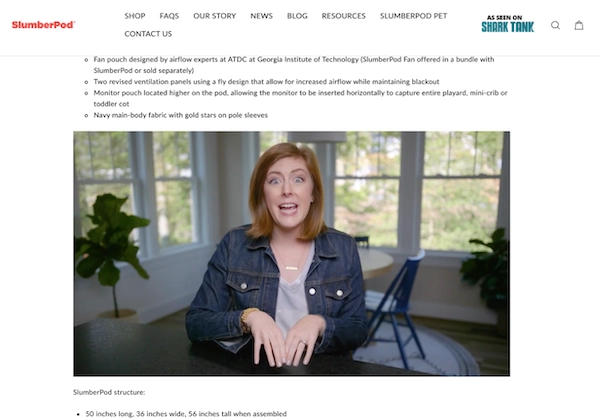
Any time you decide to host an event, you’ll want to provide details for others to learn about the event and join virtually. You can create a specific page for your event and then ask your influencers to share a link to that page in their content.
This event page should include any necessary details, as well as sign-up instructions and ways to engage with your brand during the event. If you’re co-hosting an event with your influencer, be sure to collaborate with that influencer when creating your event page.
After the event, you may want to upload the live event to your brand’s social pages and embed the video on your website.
Similar to your event page, it’s always a good idea to create a separate web page for your contests. Not only will this offer you a central location from which to share all the contest rules and prizes, but the URL will be easy to share for your influencers.
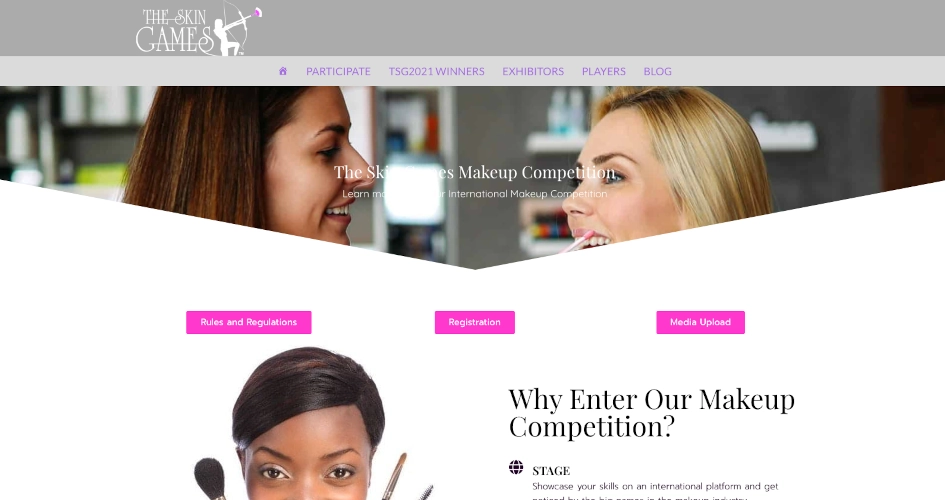
At the end of the event, you can use the same page or a new one to declare the winner and promote your next contest.
If you publish blogs on your website, influencers make great guest bloggers. Influencers tend to be highly knowledgeable about your customer pain points. Additionally, featuring a post from a famous blogger can increase excitement about your blog.
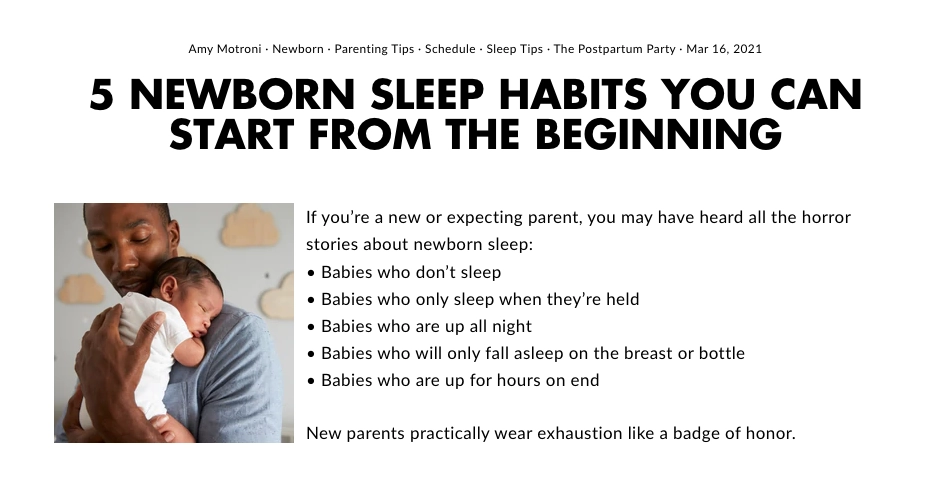
When using influencers for guest blogs, make sure they are qualified to speak to a particular topic. It’s often best to ask the influencer what they feel comfortable writing about and how the topic will benefit your audience.
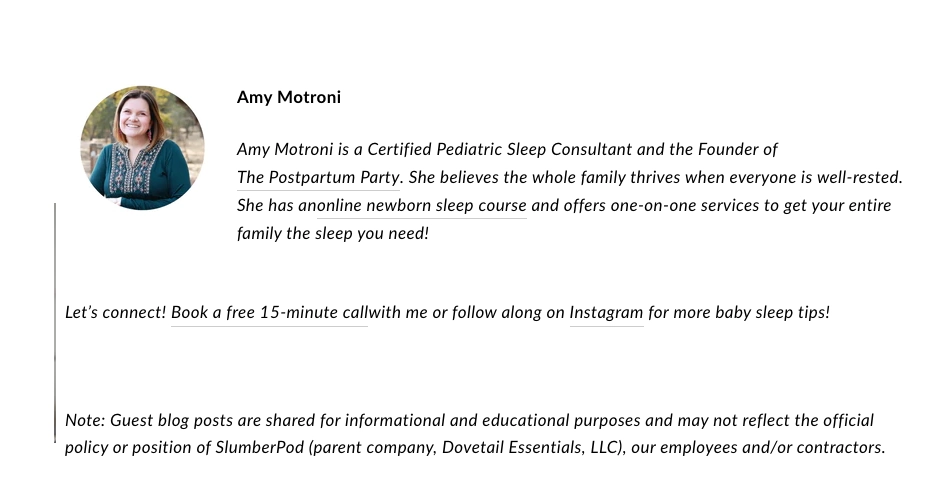
An influencer-friendly website does two main things:
To do both well means that you will need to have conversations with your influencers about how they feel about your website and how you can improve it to better connect with your audience.
Building an influencer-friendly website might look different depending on your product and industry. But the most common ways to do so are to:
Influencer-generated content can cut through the noise of digital ads and branded content to build trust with consumers. In addition to increasing your brand awareness and driving sales, influencers can give your brand credibility that would take years to achieve otherwise.
Learn more about influencer marketing: Influencer Marketing 101
Our team keeps a finger on the pulse, so you’re always working with the latest information.